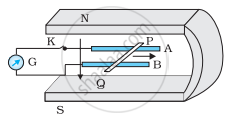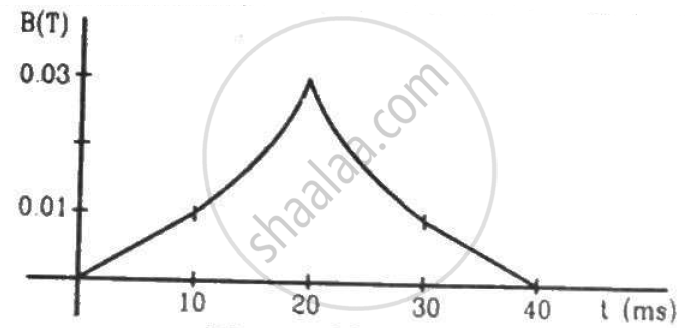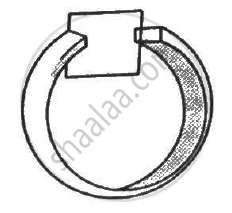Advertisements
Advertisements
प्रश्न
A conducting wire ab of length l, resistance r and mass m starts sliding at t = 0 down a smooth, vertical, thick pair of connected rails as shown in figure. A uniform magnetic field B exists in the space in a direction perpendicular to the plane of the rails. (a) Write the induced emf in the loop at an instant t when the speed of the wire is v. (b) What would be the magnitude and direction of the induced current in the wire? (c) Find the downward acceleration of the wire at this instant. (d) After sufficient time, the wire starts moving with a constant velocity. Find this velocity vm. (e) Find the velocity of the wire as a function of time. (f) Find the displacement of the wire as a function of time. (g) Show that the rate of heat developed in the wire is equal to the rate at which the gravitational potential energy is decreased after steady state is reached.

उत्तर
(a) When the speed of the wire is v, the emf developed in the loop is, e = Blv.
(b) Magnitude of the induced current in the wire, I = \[\frac{Blv}{R}\]
As wire is moving the magnetic flux passing through the loop is increasing with time. Therefore, the direction of the current should be as such to oppose the change in magnetic flux. Therefore in order to induce the current in anticlockwise direction the current flows from b to a
(c) Due to motion of the wire in the magnetic field there is a force in upward direction (perpendicular to the wire).
The magnitude of the force on the wire carrying current i is given by F = ilB
The net force on the wire = mg - F = mg - ilB
Downward acceleration of the wire due to current, \[a= \frac{mg - F}{m}\]
\[a = \frac{mg - ilB}{m}\]
\[a = g - \frac{B^2 l^2 v}{Rm} ..........\left[ \because i = \frac{Blv}{R} \right]\]
(d) Let the wire start moving with a constant velocity.
Now,
Let the speed of the wire be vm
As speed is constant, acceleration, a = 0
\[a = g - \frac{B^2 l^2 v_m}{Rm} = 0\]
\[\frac{B^2 l^2 v_m}{Rm} = g\]
\[ \Rightarrow v_m = \frac{gRm}{B^2 l^2}\]
(e) The acceleration of the wire can be expressed as time rate of change of velocity
\[\frac{dv}{dt} = a\]
\[\therefore \frac{dv}{dt} = \left( \frac{mg - B^2 l^2 v/R}{m} \right)\]
\[ \Rightarrow \frac{dv}{\frac{mg - B^2 l^2 v/R}{m}} = dt\]
\[ \int\limits_0^v \frac{m dv}{mg - \frac{B^2 l^2 v}{R}} = \int dt^t_0 \]
\[ \Rightarrow \frac{m}{- \frac{B^2 l^2}{R}} \left[ \log\left( mg - \frac{B^2 l^2 v}{R} \right) \right]_0^v = t\]
\[ \Rightarrow \frac{- mR}{B^2 l^2}\left[ \log\left( mg - \frac{B^2 l^2 v}{R} \right) - \log(mg) \right] = t\]
\[ \Rightarrow \log\left[ \frac{mg - \frac{B^2 l^2 v}{R}}{mg} \right] = \frac{- t B^2 l^2}{mR}\]
\[ \Rightarrow \log\left[ 1 - \frac{B^2 l^2 v}{Rmg} \right] = \frac{- t B^2 l^2}{mR}\]
\[ \Rightarrow 1 - \frac{B^2 l^2 v}{Rmg} = e^{- \frac{t B^2 l^2}{mR}} \]
\[ \Rightarrow \left( 1 - e^{- \frac{t B^2 l^2}{mR}} \right) = \frac{B^2 l^2 v}{Rmg}\]
\[v = \frac{Rmg}{B^2 l^2}\left( 1 - e^{- \frac{B^2 l^2 t}{mR}} \right)\]
\[ \Rightarrow v = v_m \left( 1 - e^{- \frac{gt}{v_m}} \right) ..........\left[ \because v_m = \frac{Rmg}{B^2 l^2} \right]\]
(f) The velocity can be expressed as time rate of change of position x is the position of the wire at instant t.
\[\because\frac{dx}{dt} = v\]
Thus, the displacement of the wire can be expressed as:-
\[s = \int_0^t dx = \int_0^t vdt\]
\[\therefore s = x_t - x_0 = v_m \int\limits_0^t \left( 1 - e^{- \frac{gt}{v_m}} \right) . dt\]
\[s = v_m . \left( t + \frac{v_m}{g} . e^{- \frac{gt}{v_m}} \right)_0^t \]
\[s = \left( v_m t + \frac{{v_m}^2}{g} e^{- \frac{gt}{v_m}} \right) - \frac{{v_m}^2}{g}\]
\[s = v_m t - \frac{{v_m}^2}{g}\left( 1 - e^{- \frac{gt}{v_m}} \right)\]
(g) Rate of development of heat in the wire is given by P = V × i
\[V = Blv\]
\[i = \frac{Blv}{R}\]
Therefore, the rate of development of heat in the wire is given by
\[P = Blv \times \frac{Blv}{R} = \frac{B^2 l^2 v^2}{R}\]
\[P = \frac{B^2 l^2 {v_m}^2 \left( 1 - e^{- \frac{gt}{v_m}} \right)^2}{R} ............\left[ \because v = v_m \left( 1 - e^{- \frac{gt}{v_m}} \right) \right]\]
Rate of decrease in potential energy is given by
\[\frac{dU}{dt} = \frac{d}{dt}(mgx) = mg . \frac{dx}{dt}\]
\[\frac{dU}{dt} = mgv\]
\[\frac{dU}{dt} = mg . v_m \left( 1 - e^{- \frac{gt}{v_m}} \right) .............\left[ \because v = v_m \left( 1 - e^{- \frac{gt}{v_m}} \right) \right]\]
After the steady state, i.e., t → ∞,
\[\frac{dU}{dt} = mg v_m \]
\[P = \frac{l^2 B^2}{R} {v_m}^2 \]
\[P = \frac{l^2 B^2}{R} \times v_m \times \frac{mgR}{l^2 B^2} ............\left[ \because v_m = \frac{mgR}{l^2 B^2} \right]\]
\[P = mg v_m\]
Thus, after the steady state,
\[P = \frac{dU}{dt}\]
APPEARS IN
संबंधित प्रश्न
Two cells of emf E1 and E2 and internal resistances r1 and r2 are connected in parallel. Derive the expression for the (i) emf and (ii) internal resistance of a single equivalent cell which can replace this combination.
The current flowing through an inductor of self-inductance L is continuously increasing. Plot a graph showing the variation of
Induced emf versus dI/dt
A square loop of side 12 cm with its sides parallel to X and Y axes is moved with a velocity of 8 cm s−1 in the positive x-direction in an environment containing a magnetic field in the positive z-direction. The field is neither uniform in space nor constant in time. It has a gradient of 10−3 T cm−1 along the negative x-direction (that is it increases by 10− 3 T cm−1 as one move in the negative x-direction), and it is decreasing in time at the rate of 10−3 T s−1. Determine the direction and magnitude of the induced current in the loop if its resistance is 4.50 mΩ.
Figure shows a metal rod PQ resting on the smooth rails AB and positioned between the poles of a permanent magnet. The rails, the rod, and the magnetic field are in three mutual perpendicular directions. A galvanometer G connects the rails through a switch K. Length of the rod = 15 cm, B = 0.50 T, resistance of the closed loop containing the rod = 9.0 mΩ. Assume the field to be uniform.
(a) Suppose K is open and the rod is moved with a speed of 12 cm s−1 in the direction shown. Give the polarity and magnitude of the induced emf.

(b) Is there an excess charge built up at the ends of the rods when K is open? What if K is closed?
(c) With K open and the rod moving uniformly, there is no net force on the electrons in the rod PQ even though they do experience magnetic force due to the motion of the rod. Explain.
(d) What is the retarding force on the rod when K is closed?
(e) How much power is required (by an external agent) to keep the rod moving at the same speed = (12 cm s−1) when K is closed? How much power is required when K is open?
(f) How much power is dissipated as heat in the closed circuit? What is the source of this power?
(g) What is the induced emf in the moving rod if the magnetic field is parallel to the rails instead of being perpendicular?
A circular coil of radius 10 cm, 500 turns and resistance 200 Ω is placed with its plane perpendicular to the horizontal component of the Earth's magnetic field. It is rotated about its vertical diameter through 180° in 0.25 s. Estimate the magnitude of the emf and current induced in the coil. (Horizontal component of the Earth's magnetic field at the place is 3.0 ✕ 10−5 T).
The flux of magnetic field through a closed conducting loop changes with time according to the equation, Φ = at2 + bt + c. (a) Write the SI units of a, b and c. (b) If the magnitudes of a, b and c are 0.20, 0.40 and 0.60 respectively, find the induced emf at t = 2 s.
(a) The magnetic field in a region varies as shown in figure. Calculate the average induced emf in a conducting loop of area 2.0 × 10−3 m2 placed perpendicular to the field in each of the 10 ms intervals shown. (b) In which intervals is the emf not constant? Neglect the behaviour near the ends of 10 ms intervals.

A conducting circular loop of area 1 mm2 is placed coplanarly with a long, straight wire at a distance of 20 cm from it. The straight wire carries an electric current which changes from 10 A to zero in 0.1 s. Find the average emf induced in the loop in 0.1 s.
Figure shows a conducting square loop placed parallel to the pole-faces of a ring magnet. The pole-faces have an area of 1 cm2 each and the field between the poles is 0.10 T. The wires making the loop are all outside the magnetic field. If the magnet is removed in 1.0 s, what is the average emf induced in the loop?

A conducting loop of face-area A and resistance R is placed perpendicular to a magnetic field B. The loop is withdrawn completely from the field. Find the charge which flows through any cross-section of the wire in the process. Note that it is independent of the shape of the loop as well as the way it is withdrawn.
A circular coil of radius 2.00 cm has 50 turns. A uniform magnetic field B = 0.200 T exists in the space in a direction parallel to the axis of the loop. The coil is now rotated about a diameter through an angle of 60.0°. The operation takes 0.100 s. (a) Find the average emf induced in the coil. (b) If the coil is a closed one (with the two ends joined together) and has a resistance of 4.00 Ω, calculate the net charge crossing a cross-section of the wire of the coil.
A copper wire bent in the shape of a semicircle of radius r translates in its plane with a constant velocity v. A uniform magnetic field B exists in the direction perpendicular to the plane of the wire. Find the emf induced between the ends of the wire if (a) the velocity is perpendicular to the diameter joining free ends, (b) the velocity is parallel to this diameter.
A circular copper-ring of radius r translates in its plane with a constant velocity v. A uniform magnetic field B exists in the space in a direction perpendicular to the plane of the ring. Consider different pairs of diametrically opposite points on the ring. (a) Between which pair of points is the emf maximum? What is the value of this maximum emf? (b) Between which pair of points is the emf minimum? What is the value of this minimum emf ?
A rectangular frame of wire abcd has dimensions 32 cm × 8.0 cm and a total resistance of 2.0 Ω. It is pulled out of a magnetic field B = 0.020 T by applying a force of 3.2 × 10−5N (see the following figure). It is found that the frame moves with constant speed. Find (a) this constant speed, (b) the emf induced in the loop, (c) the potential difference between the points aand b and (d) the potential difference between the points c and d.

The magnetic field in a region is given by \[\overrightarrow{B} = \overrightarrow{k} \frac{B_0}{L}y\] where L is a fixed length. A conducting rod of length L lies along the Y-axis between the origin and the point (0, L, 0). If the rod moves with a velocity v = v0 \[\overrightarrow{i},\] find the emf induced between the ends of the rod.
The current flowing in a step-down transformer 220 V to 22 V having impedance 220 π is
